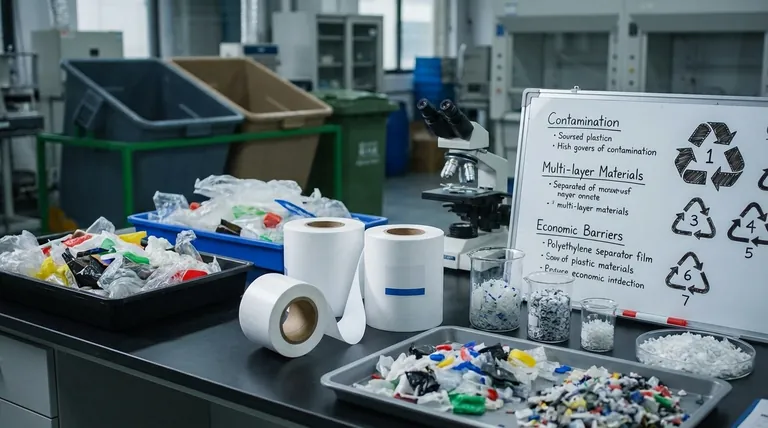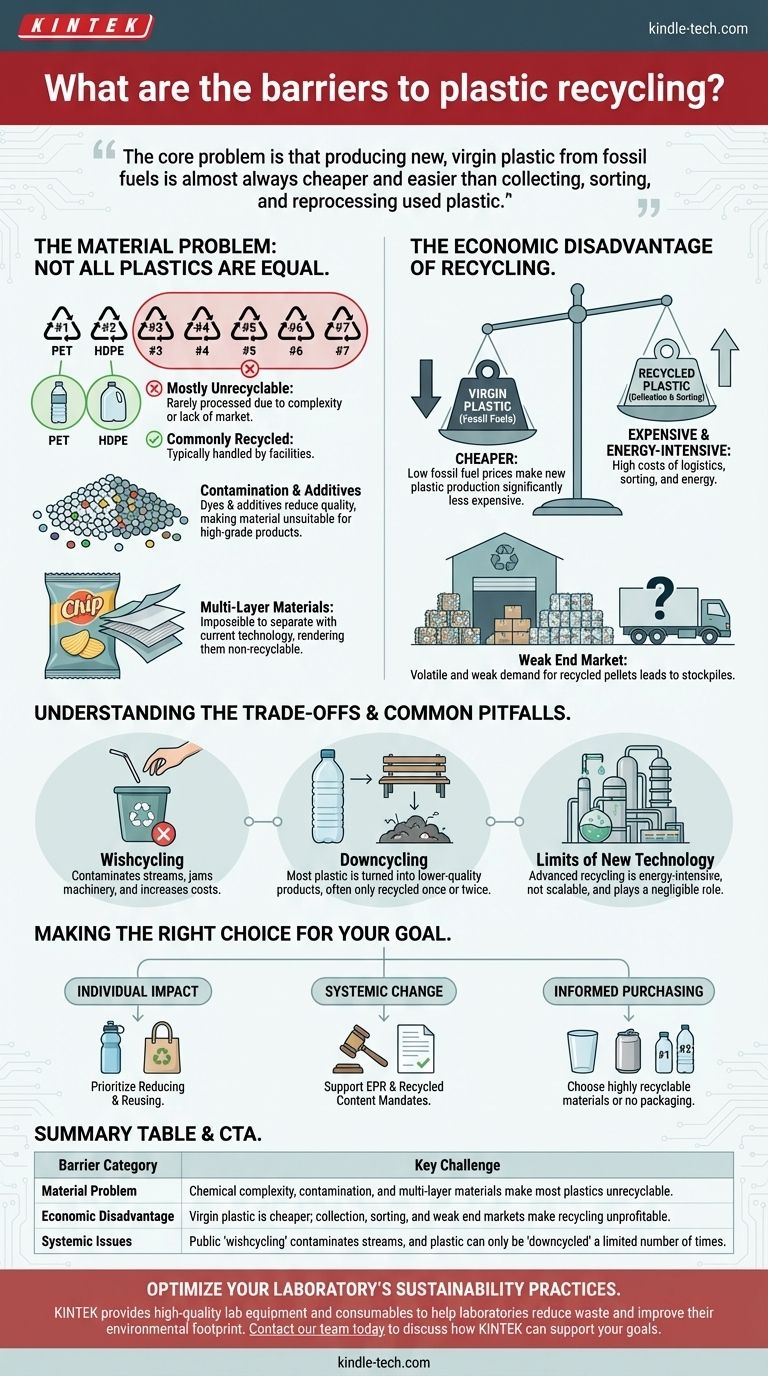The fundamental barriers to plastic recycling are a complex mix of chemical complexity, severe economic disadvantages, and failing infrastructure. While public participation is high, the system itself is not designed to handle the sheer volume and variety of plastic produced, making most of it unrecyclable in practice.
The core problem is that producing new, virgin plastic from fossil fuels is almost always cheaper and easier than collecting, sorting, and reprocessing used plastic. This economic reality undermines the entire recycling ecosystem.

The Material Problem: Not All Plastics Are Equal
The word "plastic" describes a vast family of different polymers, each with unique properties. This diversity is a feature for manufacturing but a critical flaw for recycling.
The Seven (Mostly Unrecyclable) Types
Most people are familiar with the chasing arrows symbol with a number from 1 to 7. This is a resin identification code, not a guarantee of recyclability.
In reality, recycling facilities are typically only equipped to handle #1 (PET), used in water bottles, and #2 (HDPE), used in milk jugs. The rest are rarely processed due to technical difficulty or lack of a market for the recycled material.
Contamination from Dyes and Additives
Plastics are rarely pure polymers. They contain a cocktail of chemical additives to provide color, flexibility (plasticizers), or UV protection.
These additives cannot be easily separated from the base polymer during recycling. This means the resulting material is a lower-quality, unpredictable mix, often unsuitable for making new, high-grade products.
The Challenge of Multi-Layer Materials
Many modern packages, like chip bags or juice pouches, are made of multiple, thin layers of different materials (such as plastic and aluminum foil) fused together.
These composite materials are impossible to separate with current technology, rendering them completely non-recyclable.
The Economic Disadvantage of Recycling
For recycling to be viable, it must compete with the cost of new materials. On this front, it consistently fails.
Virgin vs. Recycled Plastic Costs
Virgin plastic is produced from oil and natural gas. When fossil fuel prices are low, the cost to produce brand-new plastic is often significantly lower than the cost to process recycled plastic.
This makes it economically irrational for a manufacturer to purchase recycled pellets when higher-quality, cheaper virgin material is readily available.
The High Cost of Collection and Sorting
The logistics of plastic recycling are expensive. It involves collecting material from millions of homes, transporting it, and then using a combination of manual and automated sorting.
This process is energy-intensive, and a single contaminated item—like a greasy pizza box or a plastic bag in the wrong bin—can ruin an entire bale of material, making it worthless.
A Volatile and Weak End Market
Even when plastic is successfully processed, a buyer must exist for the resulting pellets. The demand for recycled content is often weak and highly volatile.
Without consistent demand from manufacturers, recycling facilities cannot operate profitably, leading to stockpiles of processed plastic with nowhere to go.
Understanding the Trade-offs and Common Pitfalls
The public goodwill surrounding recycling often obscures critical realities about its limitations.
The Myth of "Wishcycling"
In an effort to be environmentally conscious, many people engage in "wishcycling"—tossing questionable items like plastic bags, straws, or takeout containers into the recycling bin, hoping they can be recycled.
This practice is highly destructive. It contaminates the recycling stream, jams machinery, and dramatically increases sorting costs for municipalities, ultimately making the system less efficient.
The Illusion of Infinite Recyclability
Unlike materials like aluminum or glass, which can be recycled repeatedly with little quality loss, plastic cannot.
Most plastic is downcycled, meaning it is turned into a lower-quality product. A plastic bottle might become a park bench or carpet fiber, but it can rarely be turned back into another clear plastic bottle. This process can typically only happen once or twice before the material is unusable and ends up in a landfill.
The Limits of New Technology
Advanced or "chemical" recycling, which uses heat or chemicals to break polymers down into their original components, is often presented as a solution.
However, these technologies are still not economically or technically scalable. They are extremely energy-intensive and currently play a negligible role in global plastic waste management.
Making the Right Choice for Your Goal
Understanding these barriers reveals that recycling alone cannot solve the plastic problem. The focus must shift from end-of-life management to a more comprehensive strategy.
- If your primary focus is individual impact: Prioritize reducing and reusing above all else. Recycling should be viewed as a final, imperfect option for the very limited types of plastic that are actually processable in your area.
- If your primary focus is systemic change: Support policies like Extended Producer Responsibility (EPR), which hold manufacturers financially responsible for the waste their products create, and mandates for minimum recycled content in new products to create a stable market.
- If your primary focus is informed purchasing: Actively choose products with no packaging or packaging made from materials with high recyclability rates, like aluminum, glass, or easily identifiable #1 PET and #2 HDPE plastic.
Ultimately, addressing the plastic waste crisis requires redesigning our material systems and reducing our fundamental reliance on single-use plastics.
Summary Table:
| Barrier Category | Key Challenge |
|---|---|
| Material Problem | Chemical complexity, contamination, and multi-layer materials make most plastics unrecyclable. |
| Economic Disadvantage | Virgin plastic is cheaper; collection, sorting, and weak end markets make recycling unprofitable. |
| Systemic Issues | Public 'wishcycling' contaminates streams, and plastic can only be 'downcycled' a limited number of times. |
Optimize Your Laboratory's Sustainability Practices
While tackling plastic waste is a global challenge, improving efficiency and sustainability in your own operations is a critical first step. KINTEK specializes in providing high-quality lab equipment and consumables, helping laboratories reduce waste and improve their environmental footprint.
Are you looking for durable, reliable equipment that minimizes waste generation? Let our experts help you select the right tools for your needs.
Contact our team today to discuss how KINTEK can support your laboratory's sustainability and efficiency goals.
Visual Guide

Related Products
- Polyethylene Separator for Lithium Battery
- Button Battery Storage Box for Battery Lab
- Custom Machined and Molded PTFE Teflon Parts Manufacturer for Laboratory ITO FTO Conductive Glass Cleaning Flower Basket
- Custom PTFE Teflon Parts Manufacturer for Cleaning Racks
- Custom PTFE Teflon Parts Manufacturer for Acid and Alkali Resistant Chemical Powder Material Scoops
People Also Ask
- Is it economically viable to recycle plastic? The Harsh Economic Reality of Plastic Recycling
- What is a sustainable solution to reduce plastic waste? A Guide to the Waste Hierarchy
- What is the purpose of laminating? Protect and Enhance Your Documents for Long-Term Use
- What are three potential solutions to the plastic waste problem? A Guide to Recycling, Bioplastics & Upcycling
- What are the major components of biomass? Unlocking the Building Blocks of Renewable Energy










